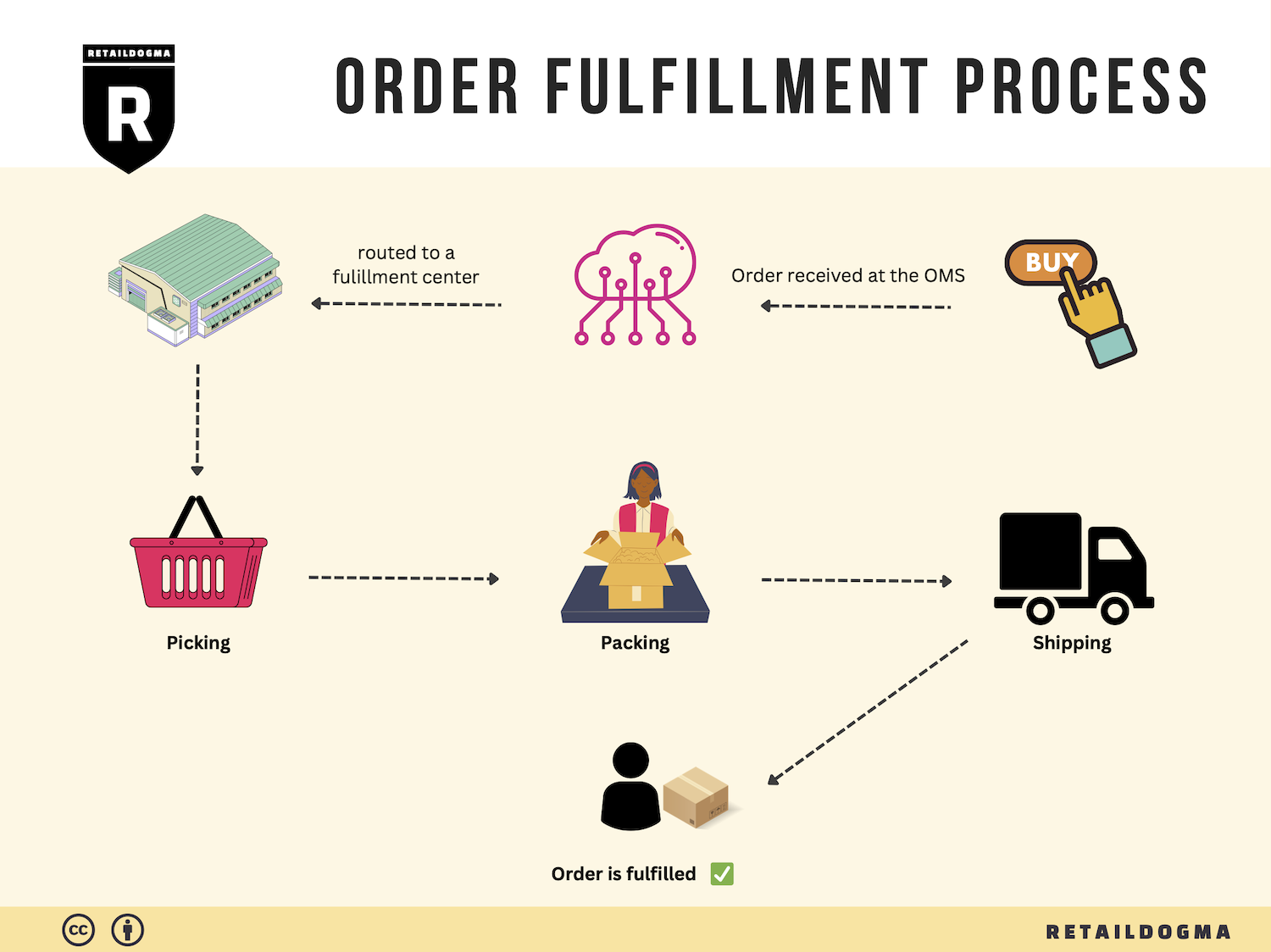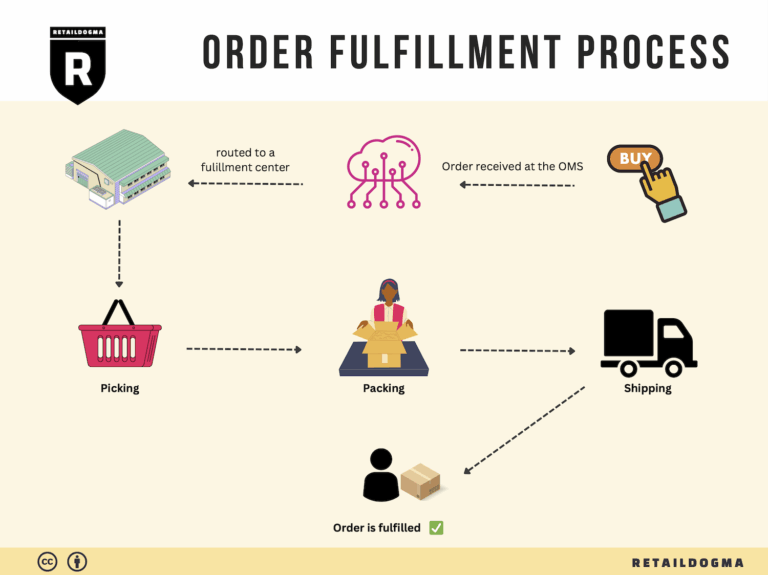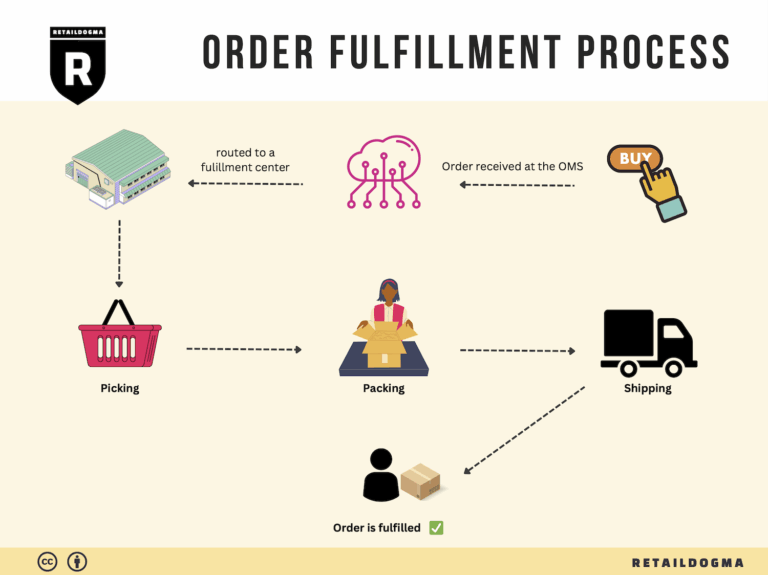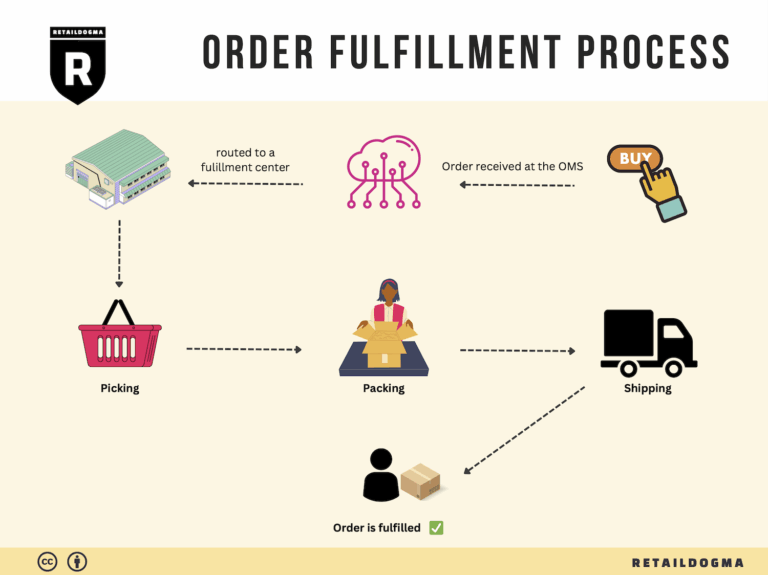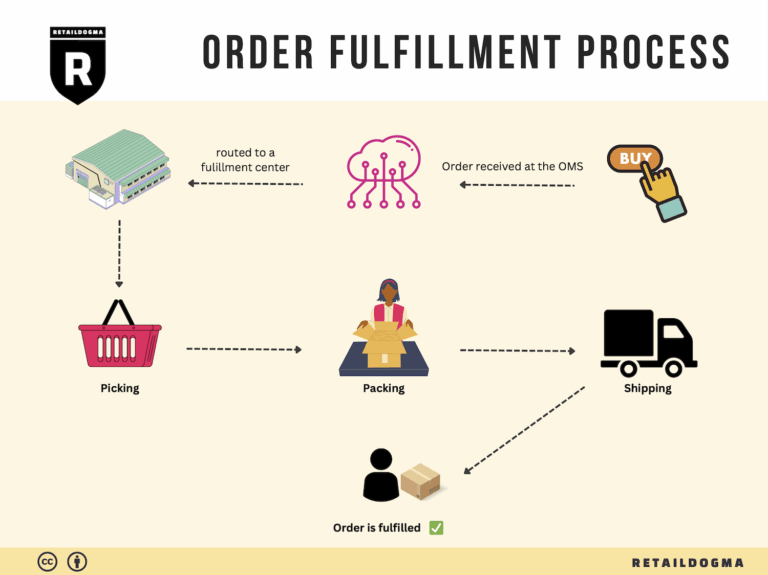Ecommerce Fulfillment Services: The Ultimate Guide (2025)
What is E-commerce Fulfillment? An Introduction for Growing Businesses
Understanding the Fulfillment Process
As an e-commerce business owner, you might find yourself increasingly overwhelmed by the complexities of packing and shipping orders. The excitement of growing sales can quickly turn into a logistical nightmare, where every order feels like a race against time. Juggling inventory management, order processing, and shipping logistics can detract from your focus on scaling your business. This is where e-commerce fulfillment comes into play.
Fulfillment, in its simplest form, refers to the entire process of getting a product from your inventory to your customer’s doorstep. It encompasses everything from receiving and storing products to picking, packing, and shipping orders, and even managing returns. As your business expands, understanding the intricacies of fulfillment becomes crucial for maintaining customer satisfaction and operational efficiency.
This guide aims to shed light on the various aspects of e-commerce fulfillment, tailored specifically for growing businesses. We will explore different fulfillment models, including Third-Party Logistics (3PL) and Fulfillment by Amazon (FBA), each offering unique advantages and challenges. Understanding these models will help you determine which aligns best with your business needs and growth trajectory.
Additionally, we will delve into the core services that fulfillment partners typically provide. These include inventory management, order processing, shipping logistics, cross-border compliance, and returns management. By grasping these services, you can better assess how a fulfillment partner can enhance your operational capabilities and customer experience.
Choosing the right fulfillment partner is a pivotal decision that can significantly impact your business’s bottom line. We’ll provide insights on the key factors to consider when evaluating potential partners, such as technology integration, cost structures, and geographic reach.
Speaking of costs, pricing is another essential element of the fulfillment process. We will break down the various pricing models you may encounter, including fixed fees, variable costs, and additional charges, enabling you to make informed financial decisions as you scale.

Ultimately, this guide aims to empower your business to make smart, strategic decisions about your logistics. With a clear understanding of e-commerce fulfillment, you can streamline your operations, enhance customer satisfaction, and focus on what you do best—growing your business.
What You’ll Learn In This Guide
- What is E-commerce Fulfillment? An Introduction for Growing Businesses
- The Order Fulfillment Process: From ‘Buy’ Button to Customer’s Door
- Comparing Fulfillment Models: In-House vs. 3PL vs. Dropshipping
- A Deep Dive into Amazon FBA: Pros, Cons, and Who It’s For
- Core Services Offered by Fulfillment Centers
- How to Choose a Fulfillment Partner: A 6-Point Checklist
- Understanding Fulfillment Pricing: A Breakdown of Common Fees
- Frequently Asked Questions (FAQs) about Fulfillment
- Conclusion: Is Outsourcing Fulfillment the Right Move for Your Business?
- Important Disclaimer
The Order Fulfillment Process: From ‘Buy’ Button to Customer’s Door
1. Receiving Inventory
The order fulfillment process begins with receiving inventory, which is the critical step where products are delivered to the fulfillment center. Upon arrival, each shipment is checked against the purchase order to ensure that the correct quantities and items have been received. This step often involves the use of Stock Keeping Units (SKUs)—unique identifiers assigned to each product for tracking purposes.
Importance: Proper receiving procedures help to minimize discrepancies and ensure that the inventory levels are accurately reflected in your inventory management system. This accuracy is essential for maintaining stock levels, preventing stockouts, and ensuring that customer orders can be fulfilled promptly.
Key Consideration: Investing in a robust Warehouse Management System (WMS) can automate the receiving process by scanning SKUs and updating inventory levels in real time. This technology not only improves accuracy but also streamlines operations, providing a foundation for efficient order processing later in the fulfillment cycle.
2. Warehouse Storage
Once inventory is received, the next step is warehouse storage. This involves organizing products within the fulfillment center in a manner that optimizes space and facilitates easy access. Effective storage strategies might include categorizing items based on demand, size, or SKU number, as well as employing FIFO (First In, First Out) practices for perishable goods.
Importance: Efficient warehouse storage is vital for maintaining an organized inventory, which directly impacts the speed of order fulfillment. A well-organized warehouse reduces the time taken to locate and pick items, thereby improving overall operational efficiency.
Key Consideration: Consider utilizing automated storage and retrieval systems (AS/RS) to enhance efficiency. These systems can significantly speed up the storage and retrieval processes, allowing for higher throughput and reduced labor costs, especially during peak seasons.
3. Order Picking
The third step in the order fulfillment process is order picking, where warehouse staff or automated systems retrieve items from storage to fulfill customer orders. This process typically involves generating pick lists, which detail the items and quantities needed for each order.
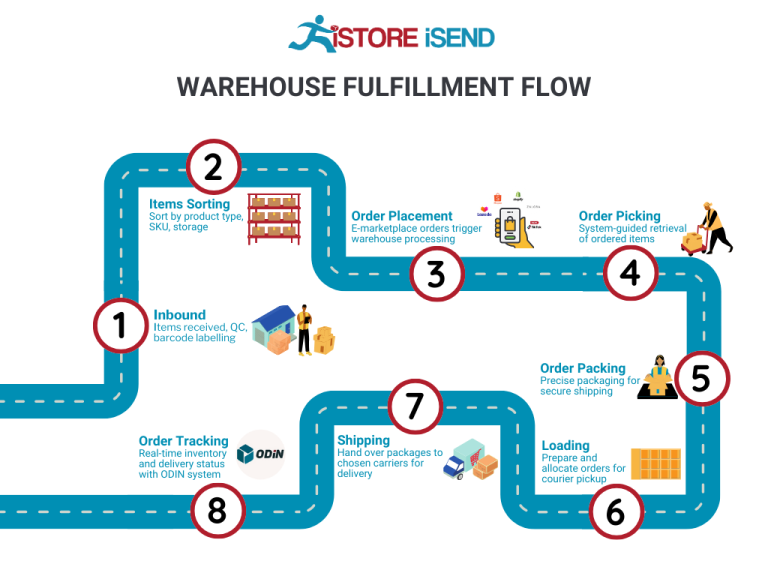
Importance: Order picking is one of the most labor-intensive aspects of fulfillment, and its efficiency can significantly affect delivery times. The faster and more accurately items are picked, the quicker the orders can be processed and shipped.
Key Consideration: Implementing batch picking—where multiple orders are picked simultaneously—can enhance efficiency, especially for high-volume operations. Additionally, using mobile devices with real-time inventory updates can help reduce picking errors and improve accuracy.
4. Order Packing
After items are picked, the next step is order packing. This involves securely packaging the products for shipping, ensuring that they are protected during transit. This step may also include adding branded materials, such as packing slips or promotional inserts, to enhance the customer experience.
Importance: Proper packing is crucial for minimizing damage during shipping and ensuring that customers receive their orders as expected. An efficient packing process can also help reduce shipping costs by optimizing package size and weight.
Key Consideration: Utilize dimensional weight pricing strategies to select the most cost-effective shipping methods. By accurately measuring the dimensions of packages, businesses can avoid unnecessary charges and improve their overall shipping costs.
5. Shipping & Delivery
The final step in the fulfillment process is shipping and delivery. Once orders are packed, they are handed over to shipping carriers for delivery to customers. This step includes generating shipping labels, selecting the appropriate shipping method, and providing tracking information to customers.
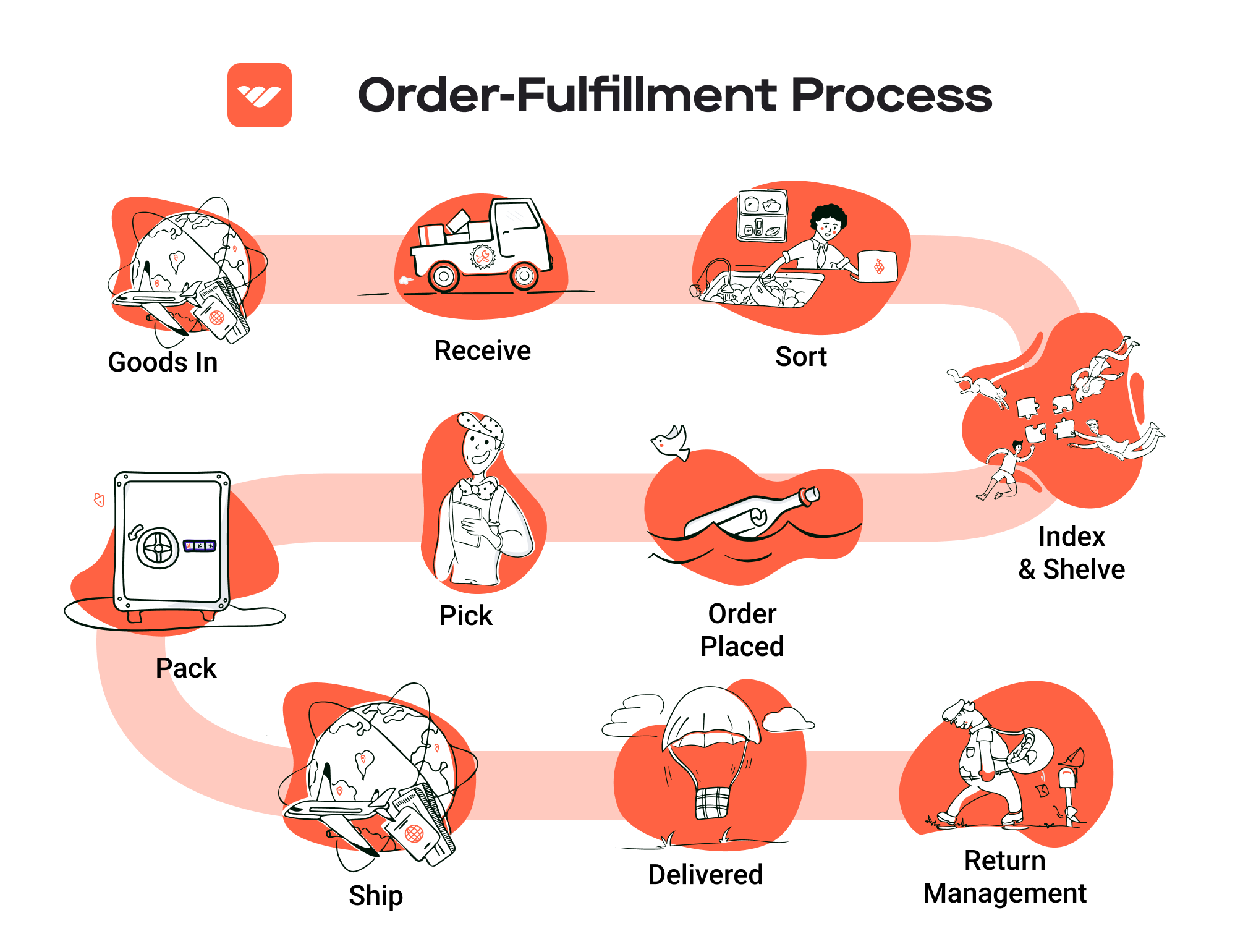
Importance: Timely and reliable shipping is critical for customer satisfaction. In today’s competitive e-commerce landscape, fast delivery options can be a key differentiator for brands looking to retain customers and foster loyalty.
Key Consideration: Integrating with multiple shipping carriers can provide flexibility and cost savings. Offering real-time tracking not only enhances transparency for customers but also allows businesses to proactively manage any potential delivery issues that may arise.
By understanding and optimizing each step of the order fulfillment process—from receiving inventory to shipping and delivery—e-commerce businesses can scale their operations effectively, improve customer satisfaction, and ultimately drive growth in a competitive marketplace.
Comparing Fulfillment Models: In-House vs. 3PL vs. Dropshipping
Fulfillment Model Comparison Table
| Model | Who Handles Inventory | Best For (Business Stage) | Key Advantage | Key Disadvantage |
|---|---|---|---|---|
| In-House Fulfillment | Your company | Startups to established brands | Full control over inventory and operations | High fixed costs and operational complexity |
| Third-Party Logistics (3PL) | 3PL provider | Growing brands and scale-ups | Scalable operations and reduced overhead | Less control over fulfillment and potential hidden costs |
| Dropshipping | Supplier | New businesses and niche markets | Low startup costs and no inventory management | Lower margins and potential for longer lead times |
In-House Fulfillment
In-house fulfillment refers to managing all aspects of order processing, inventory management, and shipping within your own company. This model is particularly suited for startups and established brands that have sufficient resources and a stable order volume. The primary advantage of in-house fulfillment is the complete control it offers over inventory, operations, and customer service. Businesses can ensure that their specific requirements are met, such as customized packaging and branding, which can enhance the customer experience. However, this control comes at a cost. The fixed expenses associated with warehousing, staffing, and maintaining logistics operations can be significant, especially for smaller businesses. Additionally, managing fulfillment in-house can lead to operational complexities, particularly as order volumes increase or when scaling into new markets. For many, the challenge of balancing fixed costs against fluctuating demand can become a major hurdle.
Third-Party Logistics (3PL)
Third-party logistics (3PL) providers offer a more flexible approach to fulfillment by outsourcing logistics functions to specialized companies. This model is ideal for growing brands and scale-ups looking to enhance their operational efficiency without the burden of managing logistics themselves. A key advantage of 3PL is scalability; as your business grows, you can easily adjust storage and fulfillment capabilities without investing heavily in infrastructure. 3PLs typically have established networks and resources that can streamline shipping, reduce costs, and improve delivery times, particularly for cross-border transactions. However, the reliance on an external provider can lead to less control over the fulfillment process, which may affect customer experience. Additionally, businesses must be cautious of potential hidden costs, such as unexpected fees for services or variations in shipping rates. To maximize the benefits of a 3PL partnership, it’s essential to choose a provider that aligns with your operational goals and offers transparency in their pricing structure.
Dropshipping
Dropshipping is a fulfillment model where the retailer does not hold inventory but instead relies on suppliers to ship products directly to customers. This model is particularly appealing to new businesses and niche markets as it requires minimal upfront investment. The primary advantage of dropshipping is the low barrier to entry; businesses can launch without the need for substantial capital tied up in inventory. Moreover, it allows for a wide product range without the risks associated with unsold stock. However, dropshipping also comes with significant disadvantages. The margins can be lower compared to other fulfillment methods, as suppliers typically take a cut of the sales. Additionally, businesses may face longer lead times, which can lead to customer dissatisfaction if not managed carefully. Quality control can also be a concern, as the retailer has limited oversight of product quality and shipping processes. For entrepreneurs considering dropshipping, it is crucial to select reliable suppliers and maintain clear communication to mitigate potential issues.
Conclusion
Choosing the right fulfillment model is critical for the success and scalability of an e-commerce business. In-house fulfillment offers control and customization but comes with higher costs and complexity. Third-party logistics provide a scalable solution with expertise and efficiency, though they may reduce control and introduce hidden costs. Dropshipping offers a low-risk entry into e-commerce, but it can lead to lower margins and potential customer service challenges. Each model has its strengths and weaknesses, and the best choice will depend on your business stage, resources, and growth ambitions. As you consider your options, align your fulfillment strategy with your overall business goals to ensure a seamless customer experience and sustainable growth.
A Deep Dive into Amazon FBA: Pros, Cons, and Who It’s For
Understanding Fulfillment by Amazon (FBA)
Fulfillment by Amazon (FBA) is a service offered by Amazon that allows e-commerce sellers to store their products in Amazon’s fulfillment centers. Amazon takes care of storage, packaging, and shipping, as well as customer service and returns for these products. This service enables sellers to leverage Amazon’s vast logistics network and customer base, providing them with a streamlined way to reach millions of potential buyers worldwide.
How FBA Works
-
Product Listing: Sellers create product listings on Amazon and specify which items they want to fulfill through FBA.
-
Inventory Shipment: Sellers ship their products to Amazon’s fulfillment centers. Amazon provides guidelines on how to package and label the products for efficient processing.
-
Storage: Once received, Amazon stores the products in their warehouses. Sellers can track their inventory levels through the Amazon Seller Central dashboard.
-
Order Processing: When a customer places an order for a product fulfilled by FBA, Amazon handles the entire fulfillment process. This includes picking the product from the warehouse, packing it, and shipping it to the customer.
-
Customer Service: Amazon manages all customer inquiries, returns, and refunds related to FBA orders, providing a seamless experience for both sellers and buyers.
-
Payment: After the sale, sellers receive payment from Amazon, minus the applicable fees for the FBA service.
Pros of Fulfillment by Amazon (FBA)
1. Prime Eligibility
One of the most significant advantages of using FBA is that products become eligible for Amazon Prime. This status attracts a vast number of Prime members who prefer to shop for items that offer fast and free shipping, significantly boosting sales potential.
2. Enhanced Customer Trust
Amazon is a trusted name in e-commerce, and using FBA adds credibility to sellers’ products. Customers often feel more secure purchasing items fulfilled by Amazon due to their robust return policies and customer service.
3. Multi-Channel Fulfillment
FBA isn’t limited to Amazon sales. Sellers can also use FBA to fulfill orders from other sales channels, such as their own websites or other e-commerce platforms. This multi-channel fulfillment capability allows sellers to streamline their operations and manage inventory more efficiently.
4. Scalability
FBA allows sellers to scale their business without the need for significant investment in logistics infrastructure. As orders increase, Amazon’s fulfillment centers can handle the surge, enabling sellers to focus on marketing and product development rather than logistics.
5. Simplified Operations
With FBA, sellers can offload many operational tasks, including storage, packing, shipping, and customer service. This allows them to focus more on strategic aspects of their business, such as product sourcing and marketing.
Cons of Fulfillment by Amazon (FBA)
1. High Fees
While FBA provides numerous benefits, it comes with costs that can add up quickly. Sellers must pay storage fees for their products in Amazon’s warehouses, as well as fulfillment fees for each order processed. These fees can significantly cut into profit margins, particularly for low-cost items.
2. Strict Inventory Rules
Amazon enforces strict guidelines regarding inventory management. Sellers must ensure their products meet Amazon’s packaging and labeling requirements, and they risk incurring additional fees for non-compliance. Additionally, there are limits on how long products can be stored without selling, which can lead to excess inventory fees.
3. Commingling Risks
FBA uses a commingling system where products from different sellers may be stored together. This can lead to issues where sellers may receive returns or negative feedback for products they did not sell. If a customer receives a defective item from a different seller, it can tarnish the original seller’s reputation.
4. Limited Control Over Shipping
While Amazon handles shipping and customer service, sellers have limited control over these processes. If there are shipping delays or issues with customer service, the seller may suffer the consequences in terms of negative reviews and lost sales.
5. Dependency on Amazon
Using FBA creates a reliance on Amazon’s platform and policies. Changes in Amazon’s fees, policies, or algorithms can significantly impact a seller’s business operations and profitability.
Who is FBA Best For?
Fulfillment by Amazon is particularly beneficial for small to medium-sized e-commerce businesses that are looking to scale quickly without the burden of managing logistics themselves. It is ideal for sellers who:
-
Sell High-Volume Products: Businesses with products that have a high turnover rate can benefit from the economies of scale that FBA offers.
-
Want to Expand into New Markets: Sellers looking to reach a broader audience, especially internationally, can take advantage of Amazon’s global reach and fulfillment capabilities.
-
Lack Logistics Infrastructure: Businesses that do not have the resources to manage their own warehousing and fulfillment can utilize FBA to streamline operations.
-
Prioritize Customer Experience: Sellers who want to provide a seamless shopping experience with reliable shipping and customer service will benefit from Amazon’s established reputation.
In conclusion, while FBA provides a powerful platform for e-commerce growth, it is crucial for sellers to carefully weigh the pros and cons. By understanding how FBA works and who it is best suited for, businesses can make informed decisions that align with their growth strategies.
Core Services Offered by Fulfillment Centers
Inventory Management & Warehousing
Effective inventory management is the backbone of a successful e-commerce operation. Fulfillment centers provide comprehensive inventory management services that ensure your products are stored efficiently and tracked accurately. These centers typically utilize advanced Warehouse Management Systems (WMS) to monitor stock levels, manage reorder points, and conduct regular stock reconciliations.
Benefits for E-commerce Businesses:
-
Real-Time Visibility: By leveraging technology, fulfillment centers offer real-time visibility into your inventory levels. This means you can make informed decisions about reordering and avoid stockouts or overstock situations that can harm cash flow.
-
Cost Efficiency: Utilizing a fulfillment center allows businesses to avoid the high costs associated with owning and maintaining warehouse space. Instead, you can pay for only the space you need and scale up or down based on demand.
-
Proximity to Customers: Many fulfillment centers operate multiple warehouses across strategic locations. This allows you to store products closer to your customer base, reducing shipping times and costs, which can significantly enhance customer satisfaction.
Pick and Pack Services
Pick and pack services involve the process of selecting products from inventory (picking) and preparing them for shipment (packing). Fulfillment centers streamline this process by employing trained staff and automated systems to ensure orders are fulfilled accurately and efficiently.
Benefits for E-commerce Businesses:
-
Accuracy and Speed: By outsourcing pick and pack services, businesses can significantly reduce errors in order fulfillment. Fulfillment centers utilize barcoding and scanning technologies to enhance accuracy and speed, ensuring that the right products reach customers without delays.
-
Scalability: As your business grows, so do your order volumes. Fulfillment centers are equipped to handle fluctuations in demand, allowing you to scale your operations without the need to hire additional staff or invest in more equipment.
-
Customized Packaging: Many fulfillment centers offer branding options for packaging, such as branded inserts and custom packing materials. This enhances the unboxing experience for customers, fostering brand loyalty and potentially leading to repeat purchases.
Kitting and Assembly
Kitting and assembly services are essential for businesses that sell products that require bundling or light assembly before shipping. This might include creating gift sets, subscription boxes, or assembling products that come in multiple parts.
Benefits for E-commerce Businesses:
-
Simplified Operations: By outsourcing kitting and assembly, businesses can streamline their operations and focus on core activities like marketing and customer service. Fulfillment centers have the expertise and resources to manage these tasks efficiently.
-
Cost Savings: Kitting can often reduce shipping costs by allowing businesses to ship a single package rather than multiple items. This can also minimize packaging waste and enhance sustainability efforts.
-
Enhanced Customer Offerings: Offering kitted products can differentiate your brand in a competitive market. By providing unique product combinations, you can attract new customers and increase average order value.
Returns Management (Reverse Logistics)
Returns management, or reverse logistics, is a critical service provided by fulfillment centers that involves handling product returns from customers. This includes processing returns, inspecting items, restocking inventory, and managing any necessary refurbishments.
Benefits for E-commerce Businesses:
-
Streamlined Returns Process: A well-managed returns process can enhance customer satisfaction. Fulfillment centers typically provide customers with Return Merchandise Authorization (RMA) labels and clear instructions, making it easier for them to return items.
-
Cost Control: Efficient returns management minimizes losses associated with returned products. Fulfillment centers inspect returned items to determine their condition and decide whether they can be restocked, refurbished, or liquidated, helping you recover as much value as possible.
-
Data Insights: Returns management can provide valuable insights into customer behavior and product performance. By analyzing return data, businesses can identify trends, address product issues, and improve overall customer experience.
In summary, partnering with a fulfillment center can provide e-commerce businesses with a suite of essential services that streamline operations, enhance customer satisfaction, and ultimately drive growth. As you consider your fulfillment strategy, understanding these core services will help you choose the right partner to support your scaling efforts effectively.
How to Choose a Fulfillment Partner: A 6-Point Checklist
Location & Warehouse Network
Importance:
The geographical location of your fulfillment partner’s warehouses is crucial for minimizing shipping costs and transit times. A well-distributed warehouse network enables quicker delivery to your customers, which is vital for maintaining competitive advantage in the e-commerce space.
Questions to Ask:
– Where are your fulfillment centers located, and how do those locations align with our primary markets?
– Do you have warehouses in regions that can help us optimize shipping times and costs?
– How do you handle international shipping and customs clearance?
Technology & Integrations
Importance:
A fulfillment partner’s technology stack should seamlessly integrate with your existing systems (like your e-commerce platform and ERP). This reduces manual work, minimizes errors, and provides real-time data visibility, which is essential for managing inventory and tracking orders.
Questions to Ask:
– What technology platforms do you use, and how do they integrate with my e-commerce system?
– Do you offer a user-friendly dashboard for tracking orders, inventory levels, and shipping status?
– How do you ensure data security and compliance with regulations like GDPR?
Specializations (e.g., Cold Storage, Oversized Items)
Importance:
Not all fulfillment partners can handle every type of product. If your business deals with specialized items—such as perishables requiring cold storage, or oversized products—it’s essential to choose a partner with the necessary expertise and facilities.
Questions to Ask:
– What types of products are you specialized in handling?
– Do you have the capability to store and ship temperature-sensitive items?
– How do you manage the logistics of oversized or bulky products?
Scalability & Capacity
Importance:
As your business grows, your fulfillment needs will evolve. A partner that can scale operations in line with your growth—whether it’s seasonal spikes or long-term expansion—is crucial to maintaining service levels and customer satisfaction.
Questions to Ask:
– How do you accommodate sudden increases in order volume?
– What is your maximum storage capacity, and how quickly can you expand if needed?
– Can you provide examples of how you’ve helped other clients scale during peak seasons?
Pricing and Contracts
Importance:
Understanding the pricing structure and contract terms is vital to avoid unexpected costs that can erode profit margins. Transparent pricing allows for better budgeting and financial forecasting, which are essential for scaling operations effectively.
Questions to Ask:
– Can you provide a detailed breakdown of your pricing model (e.g., pick-and-pack fees, storage costs, shipping rates)?
– Are there any hidden fees I should be aware of, such as for returns or excess storage?
– What are the contract terms, and is there flexibility for renegotiation as our needs change?
Customer Support & Reviews
Importance:
Reliable customer support can make or break your relationship with a fulfillment partner. Quick response times and effective problem resolution are essential for maintaining operational efficiency and customer satisfaction.
Questions to Ask:
– What is your customer support structure? Is there a dedicated account manager available?
– How do you handle issues like shipping delays or inventory discrepancies?
– Can you provide testimonials or case studies from other clients, particularly those in similar industries?
Final Thoughts
Choosing the right fulfillment partner is a critical step for any e-commerce business aiming to scale operations effectively. By using this checklist, you can systematically evaluate potential partners, ensuring they align with your operational needs and growth ambitions. As you navigate this process, remember that the right partner can significantly enhance your customer experience, optimize costs, and ultimately contribute to your business’s long-term success.
Understanding Fulfillment Pricing: A Breakdown of Common Fees
Initial Setup Fees
When partnering with a global fulfillment provider, the initial setup fees represent the costs associated with onboarding your business into their system. These fees can vary widely depending on the complexity of your operations and the provider’s infrastructure. Typically, setup fees may include the following components:
- Account Setup: Establishing your account within the fulfillment center’s system.
- Technology Integration: Costs related to integrating your e-commerce platform with the fulfillment provider’s Warehouse Management System (WMS). This integration is crucial for syncing inventory levels, order processing, and tracking.
- Onboarding Training: Training sessions for your team to understand how to use the fulfillment provider’s systems effectively.
To calculate the total initial setup fees, request a detailed breakdown from your provider, ensuring you understand each component and its associated costs. This upfront investment can significantly streamline your operations and reduce long-term overhead.
Receiving Fees
Receiving fees are incurred when your inventory arrives at the fulfillment center. These fees cover the labor and processes involved in unloading, inspecting, and storing your products. The calculation typically considers:
- Volume of Goods: The total weight or number of pallets being received can influence the fee.
- Inspection Requirements: If your goods require quality checks or special handling, additional charges may apply.
- Seasonal Variability: During peak seasons, receiving fees may fluctuate due to increased demand for labor and resources.
To get an accurate estimate of receiving fees, clarify with your provider how they determine these charges and if they offer any bundled pricing for larger shipments.
Storage Fees (per pallet/bin)
Storage fees are charged for the space your inventory occupies in the fulfillment center. These fees are typically calculated on a per-pallet or per-bin basis, depending on how your products are stored. Key factors influencing storage fees include:
- Duration of Storage: The longer your inventory remains in the warehouse, the higher the fees. Some providers may offer tiered pricing based on the length of storage.
- Type of Storage: Specialized storage (e.g., climate-controlled environments) may incur higher fees than standard storage.
- Inventory Turnover Rate: Slow-moving items may attract higher storage costs as they occupy valuable space for extended periods.
To minimize storage costs, regularly assess your inventory turnover and work with your provider to optimize your storage strategies, such as consolidating slower-moving items or utilizing on-demand warehousing.
Pick & Pack Fees (per item/order)
Pick and pack fees are incurred each time an order is processed. These fees cover the labor involved in selecting items from the warehouse and preparing them for shipment. The calculation of these fees can vary based on:
- Number of Items: The more items in an order, the higher the pick fee, as it requires more labor and time.
- Order Complexity: If your orders involve complex kitting or bundling, additional charges may apply.
- Automated Systems: Providers using automated picking systems may offer lower fees compared to those relying on manual processes.
To effectively manage pick and pack fees, consider consolidating orders when possible and working with your provider to streamline order fulfillment processes.
Shipping Fees
Shipping fees encompass the costs associated with transporting your products from the fulfillment center to your customers. These fees are influenced by several factors, including:
- Shipping Method: Rates can vary significantly based on whether you choose standard, expedited, or international shipping options.
- Destination: Shipping costs typically increase with distance and may vary by region or country.
- Carrier Relationships: Many fulfillment partners negotiate bulk shipping rates with carriers, which can impact the fees you pay.
To gain better control over shipping costs, inquire about your provider’s carrier relationships and whether they can offer discounted rates based on your shipping volume.
Tips for Getting an Accurate Quote
When seeking a quote from a fulfillment partner, consider the following tips to ensure accuracy and transparency:
- Provide Detailed Information: Share specifics about your product types, order volumes, and expected shipping destinations to receive a tailored quote.
- Request a Comprehensive Breakdown: Ask for itemized pricing on all fees, including setup, receiving, storage, pick and pack, and shipping. This transparency will help you compare providers effectively.
- Inquire About Volume Discounts: As your order volume increases, many fulfillment centers offer tiered pricing. Understanding these tiers can help you project future costs.
- Consider Long-Term Contracts: Some providers may offer better rates for longer-term commitments. Evaluate if this aligns with your growth strategy.
- Discuss Hidden Costs: Clarify any potential hidden fees, such as those for returns, special handling, or seasonal surcharges, to avoid surprises down the line.
By taking these steps, you can better navigate fulfillment pricing and choose a partner that aligns with your scaling ambitions.
Frequently Asked Questions (FAQs) about Fulfillment
1. What is global fulfillment?
Global fulfillment refers to the process of managing and delivering products to customers across international borders. It involves a network of fulfillment centers, logistics, and distribution channels that enable e-commerce businesses to efficiently ship products to global markets. This service is crucial for meeting customer expectations for fast and reliable delivery.
2. What’s the difference between a warehouse and a fulfillment center?
A warehouse is primarily used for storage, where goods are kept until needed. In contrast, a fulfillment center is a specialized facility designed to process orders. Fulfillment centers handle inventory management, order processing (picking, packing, and shipping), and often include value-added services such as returns management and customer support, making them integral to the e-commerce supply chain.
3. What is a 3PL (third-party logistics provider)?
A 3PL is a company that offers outsourced logistics services to businesses, including warehousing, transportation, inventory management, and fulfillment. By partnering with a 3PL, e-commerce businesses can leverage their expertise and infrastructure to scale operations, reduce costs, and enhance customer satisfaction without managing logistics in-house.
4. How much do fulfillment services cost?
The cost of fulfillment services varies widely based on factors such as order volume, product type, destination, and the specific services required (e.g., storage, packing, shipping). Typically, costs include pick-and-pack fees, storage fees, shipping rates, and any additional services like returns processing. It’s essential to evaluate different fulfillment partners to find the best pricing structure that aligns with your business needs.
5. How can I choose the right global fulfillment partner?
When selecting a global fulfillment partner, consider factors such as their geographic reach, technological capabilities, service offerings (including cross-border compliance and returns management), and reputation. Evaluate their integration with your existing systems (like your e-commerce platform) and assess their ability to scale with your growth.
6. What are the benefits of using global fulfillment services?
Global fulfillment services offer several advantages, including reduced shipping times, lower costs through optimized logistics, access to international markets, and improved customer satisfaction. By outsourcing fulfillment, businesses can focus on core operations like marketing and product development while leaving logistics to experts.
7. How does consumer behavior impact global fulfillment strategies?
Consumer behavior influences fulfillment strategies by dictating expectations for delivery speed, cost, and service quality. As trends shift towards faster shipping and more personalized experiences, businesses must adapt their fulfillment operations to meet these demands, often requiring advanced technology and strategic partnerships.
8. What are the challenges of international fulfillment?
Challenges of international fulfillment include navigating customs regulations, managing shipping costs, dealing with longer transit times, and ensuring accurate delivery tracking. Additionally, businesses may face complications related to returns processing and customer service in different markets, necessitating a robust global logistics strategy.
9. What role does technology play in global fulfillment?
Technology plays a critical role in global fulfillment by enabling real-time inventory management, order tracking, and data analytics. Integration with e-commerce platforms and warehouse management systems (WMS) helps streamline operations, reduce manual errors, and improve overall efficiency, allowing businesses to scale effectively.
10. How can I minimize shipping errors in my fulfillment process?
To minimize shipping errors, implement robust inventory management systems, utilize barcode scanning, and maintain clear communication with your fulfillment partner. Regular audits of your fulfillment processes, along with training for staff on best practices, can also help reduce mistakes and enhance accuracy in order processing.
Conclusion: Is Outsourcing Fulfillment the Right Move for Your Business?
The Case for Outsourcing Fulfillment
Outsourcing your fulfillment can be a transformative move for your e-commerce business. By leveraging a dedicated fulfillment partner, you gain access to a suite of benefits that can significantly enhance your operations.
First and foremost, outsourcing saves you time. Managing logistics in-house often leads to operational bottlenecks, drawing focus away from strategic growth initiatives. A fulfillment partner handles everything from warehousing and inventory management to order processing and returns, allowing your team to concentrate on core business activities like marketing and customer engagement.
Scalability is another critical advantage. As your business grows, so do the complexities of fulfillment. A reliable partner can seamlessly adjust to increased order volumes, ensuring that you maintain high service levels without the need for substantial investment in infrastructure. This flexibility can be especially valuable during peak seasons or unexpected surges in demand.
Moreover, partnering with an expert fulfillment provider brings specialized knowledge and resources to the table. These professionals understand the intricacies of international shipping, compliance, and inventory management, reducing the likelihood of costly errors and improving overall efficiency. They also keep you updated with evolving consumer expectations, allowing you to stay competitive in the fast-paced e-commerce landscape.
However, the success of outsourcing fulfillment hinges on selecting the right partner. Conduct thorough due diligence to ensure that the provider aligns with your business goals, offers transparent pricing, and possesses the necessary technology integrations.
To determine if outsourcing fulfillment is the right next step for your business, consider conducting an audit of your current shipping processes. Assess your operational challenges, shipping costs, and customer satisfaction levels. This critical evaluation will help you decide if a fulfillment partner could drive your business toward greater efficiency and growth.
Important Disclaimer
⚠️ Important Disclaimer
The information in this guide is for educational purposes. Fulfillment services, pricing, and platform features change frequently. Always conduct your own due diligence and consult with providers directly before making business decisions.
